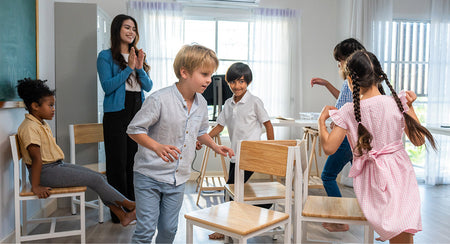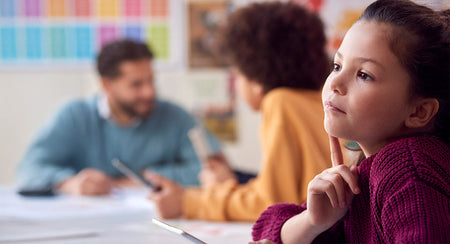Building Student Learning Engagement: Where You Start Matters
Convincing students to learn requires more than calling the class to order. We need to gain students’ attention, build their motivation, and capture their engagement. As obvious as this challenge may be, it is not always easy. Of course, students at times may be naturally interested and ready to learn what we want to teach. More often, we need to design an introduction that stimulates interest, generates questions, or surprises students in ways that lead them to choose to learn.
Fortunately, there are several “tried and true” strategies we can utilize to increase the probability that students will respond in ways that build the momentum necessary to sustain a teaching and learning cycle. Let’s explore seven potential starting places to consider, depending on the age and maturity of our students and the content we intend to teach.
Have students investigate before teaching a new concept or skill. Multiple research studies have shown that when students try to solve a problem or find answers on their own, they become more motivated to be taught approaches and processes that lead to success. For example, before teaching proportions, we might present students with the challenge of serving ten people equally with a recipe that serves four. Or we might teach the concept of main idea by having students read a paragraph, pick out the most important sentence, and discuss their selection with a classmate.
Introduce new content by discussing its purpose and establishing learning goals. We know that when students see a purpose for their learning, they are more likely to pay attention, but when the purpose is paired with a specific learning goal motivation and commitment will grow. As examples, we might note how choices people have made in the past shape today’s world and use that concept to present the goal that requires students to develop a museum exhibit showing how a decision from history impacts their lives. Or we might discuss why it is important to understand the power of persuasion techniques and give students the goal of writing a short ad that applies at least two persuasion strategies.
Offer meaningful choice and autonomy. We know that when students can make choices about their learning, they tend to take greater ownership and display higher levels of commitment. When combined with reasonable autonomy over what and how they will learn, learning choices take on new meaning and depth. Opportunities to engage in well-designed project-based learning activities, choices about how students will demonstrate their learning, and options for the level of challenge students want to pursue can significantly increase readiness to learn and drive greater commitment and persistence. These experiences also often become memorable for students because of the rich experiences the learning process offered.
Combine learning a new skill with the promise of students using it to create something new or unique. We typically introduce new skills through explanation and demonstration. We then judge whether students have learned the skill by having them apply it. However, when we take the process one step further and invite students to use the new skill to create something, we build a level of connection and ownership that can drive learning to new levels. As examples, we might introduce the mechanics of writing dialogue that sounds natural and then have students create a short play or scene in which the characters engage in and resolve an argument. Or we might introduce the concept of controlled experiments and then have students design and conduct their own experiment, such as testing the characteristics of paper airplanes that fly the farthest.
Link in-school learning with out-of-school life. Students become more interested when they see how what they are learning connects to what they see as “real life.” By pointing out connections and using examples from out-of-school life we can increase the relevance students see in what they are asked to learn. Additionally, students become better at making connections between formal learning and informal life. As examples, we might ask students if they would like to be more effective at convincing their parents to extend their curfew, allow them to apply for a job, or agree to some other request, and then show them how they can use data, argument, and other persuasion techniques to become more successful. Or we could discuss with students the songs that seem to “stay in their heads.” We can then follow up by teaching the roles of rhythm and melody in music composition.
Tie new learning to emotions. Emotions are powerful drivers of learning. In fact, the presence of strong emotions does not just make learning more meaningful, it extends recall of what is learned—often for a lifetime. The emotions can be happy or sad. They may stimulate caring or generate outrage. Whether emotions are positive or negative is less important than their strength. As examples, we might ask students to think about and describe a time when they felt especially happy, sad, lonely, or angry and then introduce them to how poets use words and structure to capture and communicate feelings. We might follow-up by having students write about their selected experience using techniques practiced by poets. Or we could have students reflect on times they have felt their heart race because of excitement or nervousness and then introduce the physical-neuro-emotional connections that produce this experience.
Introduce new content with shock, surprise, or intrigue. Unexpected, unusual, and unique information and experiences build interest and stimulate curiosity. When we tap these elements, we can pull students in to hear an explanation and beg for more information. As examples, we might share with students that in the 18th century many doctors believed that diseases were spread by smell. Consequently, they carried flowers or wore nose cones containing fragrances to ward off diseases. We might use this information to challenge students to investigate other practices throughout history or even today that are based on faulty assumptions. Or we might present a mystery object that relates to what we want students to learn and ask them to speculate on what it is and how it might be used.
Finding ways to help students get ready to learn can be as important to success as the content and skills we want to teach. By taking some time to capture students’ attention and stimulate their curiosity, we can make the work of teaching and learning easier and more effective. All we need is some imagination and a little planning.















